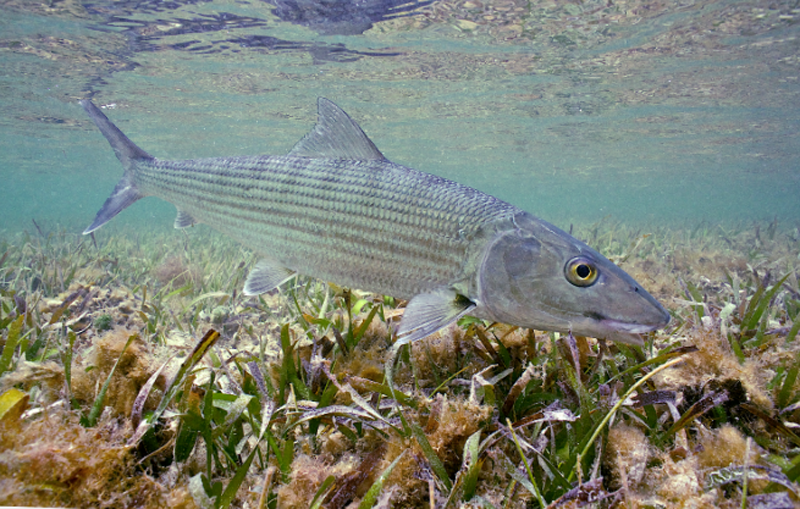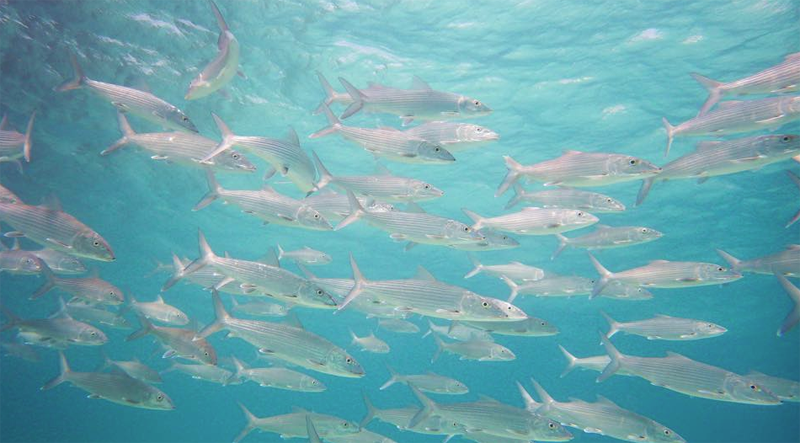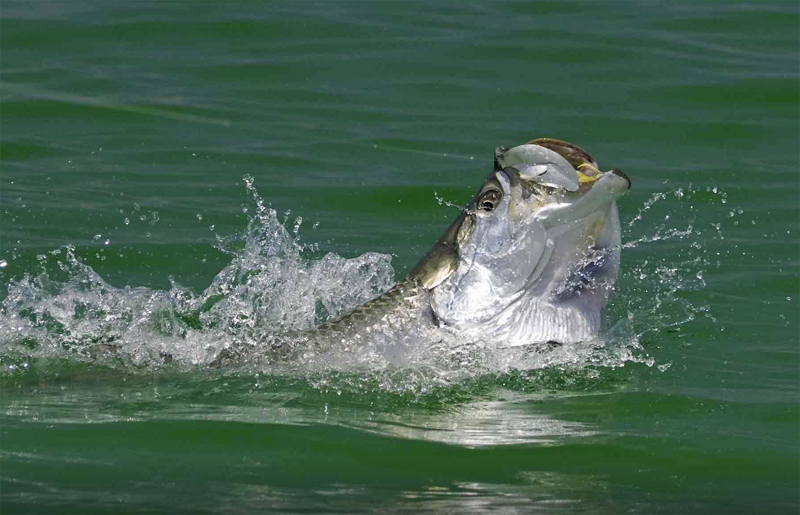
Bonefish [Albula vulpes]. Bonefish are basically schooling fish. The smaller ones can be seen in large schools on the flats. The larger ones tend to form smaller schools or groups. They feed on crabs, shrimp, clams, sea worms, sea urchins, and small fish that inhabit the sandy flats and intertidal areas. They are often seen rooting in the sand, their tails breaking the surface of the shallow water; an action commonly known as “trailing”. At other times they will plough the bottom stirring up silt and marl, known as “mudding”. They are powerful and run very fast and hard when hooked. Fishing methods include plug, fly or spin casting from a skiff or while wading on tidal flats, using shrimp, crabs or similar baits. Most bonefish are caught in depths from 6 inches to 10 ft (15 cm to 3 m).IGFA World Records: BONEFISH All Tackle – 16 lbs ( 7.25 kg) and Tippet Class with 20#test. [Photo: Nadine Slimak].
BTT’s Bonefish Genetics Study Reveals Connectivity Across the Caribbean
BTT has completed its multi-year Bonefish Genetics Study, the results of which provide scientific evidence that the bonefish population across the Caribbean is closely connected. The study, which launched in 2014, involved the collection of genetic samples from bonefish (Albula vulpes) in multiple locations spanning the region. With the assistance of anglers, guides, and partners, BTT surpassed its initial target of collecting 5,000 samples, ultimately receiving 13,359 from a diversity of locations, including South Florida and the Keys, The Bahamas, Mexico, Belize, Cuba, Honduras, Nicaragua, the Cayman Islands, Puerto Rico, and elsewhere. The majority of samples were from Florida, Bahamas, Cuba, Mexico, and Belize. Given that the study’s primary inquiry concerned connections to Florida, the most intensive analyses addressed Belize, Mexico, Florida, Cuba, and The Bahamas.
The samples underwent a thorough analysis by BTT’s collaborating scientists at the Florida Fish and Wildlife Commission (FWC). Of the 13,359 total samples, 11,222 were used for analysis. 1,588 fish were identified as other species (remember that Albula vulpes supports the fishery), and 549 samples were too degraded for analysis and were discarded.
The analytical approach included several levels:
- One level of analysis examined a couple of locations (alleles) on bonefish genes for all samples (adults, juveniles, and larvae) to determine how well bonefish throughout the region shared these alleles;
- Another level of analysis compared specific sites on the DNA among individuals to determine their level of relatedness;
- Another level of analysis examined genetic information between adults and larvae/juveniles to determine if parent-offspring relationships could be determined;
- Another level of analysis looked for sibling relationships.

This spawning run is where it’s at for these bones—photo BTT.
The Findings
Bonefish (Albula vulpes) throughout the Caribbean share genetic composition to a great extent, indicating that bonefish in all of the locations that were sampled are part of a single genetic population. However, it appears that the distance between locations influences the degree of relatedness. For example, although bonefish in the eastern Caribbean share genetic composition with bonefish in the western Caribbean and Florida, fish in these locations are unlikely to be directly related. In other words, there are probably many generations between eastern and western Caribbean bonefish. The larvae of a bonefish that spawns in Vieques may end up in Honduras. When those larvae become adult bonefish and spawn, some of their larvae end up in Mexico. And when those fish spawn, some of their larvae may end up in the Florida Keys.
At smaller geographic scales, the connections are more direct.
- There appears to be reasonably high connectivity between Cuba and the Bahamas;
- There appears to be reasonable high connectivity between Belize/Mexico and Cuba;
- There appears to be high connectivity between Belize/Mexico and Florida;
- There appears to be limited direct connectivity between Cuba and Florida.
But when Belize, Mexico, Cuba, and Florida samples are combined, they are deemed as highly connected. There is also a high level of connectivity among islands in The Bahamas.
The results of the Bonefish Genetics Study underscore the need for conservation and improved fishery management at local and regional scales that transcend international boundaries. BTT’s next steps will be to examine more closely the pathways of connection, which will bring into focus the areas that BTT and its partners need to prioritize for conservation.
A Summary of BTT’s Conservation Work in Belize and Mexico
April 27, 2020
Things We Know About Juvenile Tarpon
April 24, 2020
What We’ve Learned About Bonefish: 5 Part Story
April 10, 2020 – This series of blog posts will summarize five exciting discoveries about bonefish biology made by Bonefish & Tarpon Trust and our collaborators over the past 20 years. Contributors: Justin Lewis, Dr. Aaron Adams, and Dr. Ross Boucek.
Join bonefish & Tarpon Trust and find out how to fish the flats for bonefish, tarpon, and permit and support research or volunteer to participate in the study of these iconic game fish.

Tarpon [Megalops atlanticus]. Occurs in warm temperate tropical and subtropical waters of the Atlantic Ocean. This coastal fish can be found both inshore and offshore. Because of its ability to gulp air directly into the air bladder by “rolling” at the surface, the tarpon is able to enter brackish and fresh waters that are stagnant and virtually depleted of oxygen. Such areas are relatively free of predators, thus offering a convenient refuge for the young. TARPON IGFA World Record All Tackle – 286 lbs 9oz (129.98 kg); Tippet Class – 202 lbs, 8 oz with 20# test. Photo Bonefish & Tarpon Trust.

